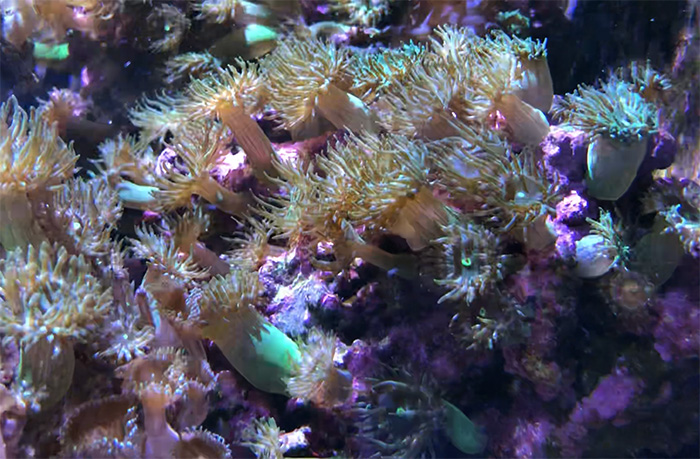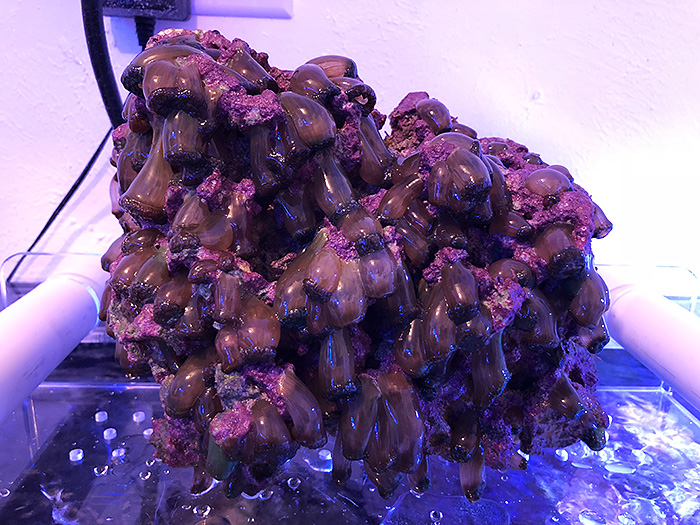When a pest like Manjano Anemones (Anemonia manjano) are spotted in a reef aquarium, there are a number of removal methods to choose from. I recently allowed them to grow rampant in my frag tank, essentially ignoring the problem for much too long. In this video, I demonstrate how I took the time to scrape them off the rockwork one by one until the reef was free of them. It took me a few days, working on one section at a time for about an hour each session.
Scraping Manjanos off the rockwork is an effective solution that won’t adversely affect the reef tank. Spending a few hours on this task will restore the aquarium back to a healthy state, and once you’re done you’ll feel a lot better about it. This is simply one approach that you can consider, and it’s free!
Safety First
Things to consider: You might prefer to wear gloves. Myself, I didn’t feel the need. I wear glasses, but if you don’t, be sure to wear eye protection in case these anemones squirt water toward your face. Also, keep your mouth shut for the exact same reason.
Leave No Stone Unturned
I scraped clean about a dozen pieces of live rock, maybe more. Some areas were cleared more quickly since the pests were on dead coral skeleton instead of actual rock, which allowed me to pry off multiple pests on chunks of skeleton. I used blue lighting to spot any stragglers, studying the rock by turning it around and around. I often found an errant one hidden on the underside.
Sometimes, it was necessary to chip away at the rock with bone cutters to get all of the animal out (you don’t want to leave any bit of tissue behind). Any tiny piece of anemone flesh missed may very well grow into a new anemone. That is why you’ll observe in the video how I continually scrape away at those smaller bits; I definitely don’t want to have to do this project all over again. As soon as I am done, the piece of live rock goes back into the tank and then I pull out the next one to scrape it clean.
Pace Yourself, but Work Quickly
The biggest benefit of this process is that you complete the job in a few days, restoring the tank back to what it should look like without destroying the bacteria in and on the rock itself. With all the rocks devoid of pests, you’ll be able to aquascape anew to get the desired look.
If you get tired, take a break. There’s no reason to do this all in a single session, but you will definitely want to get back to this project within a day or two since Manjanos have the tendency to travel and spread across the rockwork. They need light to thrive, which is why you’ll see them on the rockwork in plain sight, unlike Aiptasia that may be anywhere in a reef, even in dark spots deep within the rock structures. Manjanos will also climb up the walls of the aquarium, clinging to corals, powerheads, power cords, cleaning magnets…any surface that is getting hit with light, basically.
Why Manjanos Deserve Removal
You might be wondering what’s wrong with Manjano Anemones and asking yourself why they need to be removed. Manjanos spread rapidly, tearing themselves in half to propagate, covering every rock that could otherwise be used for coral placement. Some aquarists might even like the look of a field of Manjanos and be happy to run a tank full with them. When I originally spotted some of these in a fish store many years ago, I thought they were pretty, and I assumed they were tiny bubble tip anemones. I liked them enough to actually buy some, and the unscrupulous fish store owner charged me $20 for four of them. Within a few weeks, there were 50 in my 29-gallon aquarium, and I realized I’d made a big mistake. Basically, they are the reef aquarium equivalent of Tribbles, and most hobbyists don’t want them in their system.
I cleaned out the acrylic workstation tray several times during this project and remained vigilant to not allow any to pass through the tiny holes back into the tank. One minor but useful suggestion I’d offer: place a sponge in the tray to swipe cleaning tools against to more quickly remove any anemone tissue.
In conclusion, this method didn’t throw the tank back into a cycle, nor does it affect the coralline growth. The fish, remaining corals, and inverts were completely unaffected. That in itself is a big win to me.
Watch Marc Levenson’s Manjano removal video and see why he says, “Sometimes, the best solution is to just get your hands dirty.”






